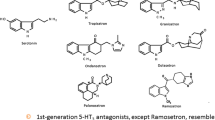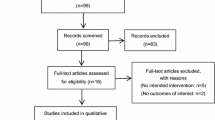Abstract
Even with the development of the serotonin 5-HT3 receptor antagonists in recent years, postoperative nausea and vomiting (PONV) remains a significant concern for clinicians and patients. For the selection of an appropriate antiemetic strategy for PONV, economic considerations should be taken into account. A literature search covering the period from September 1996 to August 2005 yielded 16 economic evaluations on antiemetics used for the prevention or treatment of PONV. In these studies, a variety of different antiemetic regimens were evaluated, with different doses and timing of administration, in many different populations, for various types of surgery, and in different settings. In addition, there were many differences in the design of these economic evaluations in terms of the extent of the costs considered and the decision rules used when forming conclusions. Therefore, despite the availability of economic evaluations on antiemetics in PONV, it is difficult to draw clear conclusions with such disparate information.
In spite of these limitations, key learning can be drawn from these economic evaluations. From studies where a placebo was used as a comparator, we can conclude that there is clinical benefit in using an antiemetic for the prevention of PONV versus no therapy. The dose of the 5-HT3 receptor antagonist seems more important in determining cost effectiveness than the selection of the agent itself, and less expensive agents such as droperidol, dexamethasone and prochlorperazine may also represent cost-effective alternatives to 5-HT3 receptor antagonists.
In an additional six studies where a willingness to pay (WTP) to avoid or reduce the incidence of PONV was estimated, the average WTP amounts varied from $US29 to $US117.
Many questions remain unanswered about the cost effectiveness of existing antiemetics and their regimens, and little is known about the impact of new agents, such as the neurokinin-1 receptor antagonists, in the control of PONV.


Similar content being viewed by others
References
Lerman J. Surgical and patient factors involved in postoperative nausea and vomiting. Br J Anaesth 1992; 69 (7 Suppl. 1): 24S–32S
Apfel CC, Laara E, Koivuranta M, et al. A simplified risk score for predicting postoperative nausea and vomiting: conclusions from cross-validations between two centers. Anesthesiology 1999; 91 (3): 693–700
Sinclair DR, Chung F, Mezei G. Can postoperative nausea and vomiting be predicted? Anesthesiology 1999; 91 (1): 109–118
Apfel CC, Kranke P, Eberhart LH, et al. Comparison of predictive models for postoperative nausea and vomiting. Br J Anaesth 2002; 88 (2): 234–240
Pierre S, Benais H, Pouymayou J. Apfel’s simplified score may favourably predict the risk of postoperative nausea and vomiting. Can J Anaesth 2002; 49 (3): 237–242
Gan TJ, Meyer T, Apfel CC, et al. Consensus guidelines for managing postoperative nausea and vomiting. Anesth Analg 2003; 97 (1): 62–71
Watcha MF. The cost-effective management of postoperative nausea and vomiting. Anesthesiology 2000; 92 (4): 931–933
Gan TJ. Postoperative nausea and vomiting: can it be eliminated? JAMA 2002; 287 (10): 1233–1236
Watcha MF. Postoperative nausea and emesis. Anesthesiol Clin North America 2002; 20 (3): 709–722
Macario A, Weinger M, Carney S, et al. Which clinical anesthesia outcomes are important to avoid? The perspective of patients. Anesth Analg 1999; 89 (3): 652–658
Jenkins K, Grady D, Wong J, et al. Post-operative recovery: day surgery patients’ preferences. Br J Anaesth 2001; 86 (2): 272–274
Myles PS, Williams DL, Hendrata M, et al. Patient satisfaction after anaesthesia and surgery: results of a prospective survey of 10,811 patients. Br J Anaesth 2000; 84 (1): 6–10
Eberhart LH, Morin AM, Wulf H, et al. Patient preferences for immediate postoperative recovery. Br J Anaesth 2002; 89 (5): 760–761
Hirsch J. Impact of postoperative nausea and vomiting in the surgical setting. Anaesthesia 1994; 49 Suppl.: 30–33
White PF. Prevention of postoperative nausea and vomiting: a multimodal solution to a persistent problem. N Engl J Med 2004; 350 (24): 2511–2512
Diez L. Assessing the willingness of parents to pay for reducing postoperative emesis in children. Pharmacoeconomics 1998; 13 (5): 589–595
Gan T, Sloan F, Dear GL, et al. How much are patients willing to pay to avoid postoperative nausea and vomiting? Anesth Analg 2001; 92 (2): 393–400
Gan TJ, Ing RJ, de LD, et al. How much are patients willing to pay to avoid intraoperative awareness? J Clin Anesth 2003; 15 (2): 108–112
Lee A, Gin T, Lau AS, et al. A comparison of patients’ and health care professionals’ preferences for symptoms during immediate postoperative recovery and the management of postoperative nausea and vomiting. Anesth Analg 2005; 100 (1): 87–93
Tang J, Wang B, White PF, et al. The effect of timing of ondansetron administration on its efficacy, cost-effectiveness, and cost-benefit as a prophylactic antiemetic in the ambulatory setting. Anesth Analg 1998; 86 (2): 274–282
Engoren M, Steffel C. Patient perception of monetary value to avoiding unpleasant side effects of anesthesia and surgery. J Clin Anesth 2000; 12 (5): 388–391
Cieslak GD, Watcha MF, Phillips MB, et al. The dose-response relation and cost-effectiveness of granisetron for the prophylaxis of pediatric postoperative emesis. Anesthesiology 1996; 85 (5): 1076–1085
Olutoye O, Jantzen EC, Alexis R, et al. A comparison of the costs and efficacy of ondansetron and dolasetron in the prophylaxis of postoperative vomiting in pediatric patients undergoing ambulatory surgery. Anesth Analg 2003; 97 (2): 390–396
Sennaraj B, Shende D, Sadhasivam S, et al. Management of post-strabismus nausea and vomiting in children using ondansetron: a value-based comparison of outcomes. Br J Anaesth 2002; 89 (3): 473–478
Subramaniam B, Madan R, Sadhasivam S, et al. Dexamethasone is a cost-effective alternative to ondansetron in preventing PONV after paediatric strabismus repair. Br J Anaesth 2001; 86 (1): 84–89
Chen JJ, Frame DG, White TJ. Efficacy of ondansetron and prochlorperazine for the prevention of postoperative nausea and vomiting after total hip replacement or total knee replacement procedures: a randomized, double-blind, comparative trial. Arch Intern Med 1998; 158 (19): 2124–2128
Chang P, Okamoto M, Chen J, et al. Cost-effectiveness analysis of ondansetron and prochlorperazine for the prevention of postoperative nausea and vomiting. J Manag Care Pharm 2005; 11 (4): 317–321
Hill RP, Lubarsky DA, Phillips-Bute B, et al. Cost-effectiveness of prophylactic anti-emetic therapy with ondansetron, droperidol, or placebo. Anesthesiology 2000; 92 (4): 958–967
Meyer TA, Roberson CR, Rajab MH, et al. Dolasetron versus ondansetron for the treatment of postoperative nausea and vomiting. Anesth Analg 2005; 100 (2): 373–377
Paech MJ, Rucklidge MW, Banks SL, et al. The efficacy and cost-effectiveness of prophylactic 5-hydroxytryptamine3 receptor antagonists: tropisetron, ondansetron and dolasetron. Anaesth Intensive Care 2003; 31 (1): 11–17
Pueyo FJ, Lopez-Olaondo L, Sanchez-Ledesma MJ, et al. Cost-effectiveness of three combinations of anti-emetics in the prevention of postoperative nausea and vomiting. Br J Anaesth 2003; 91 (4): 589–592
Tang J, Watcha MF, White PF. A comparison of costs and efficacy of ondansetron and droperidol as prophylactic anti-emetic therapy for elective outpatient gynecologic procedures. Anesth Analg 1996; 83 (2): 304–313
Tang J, Chen X, White PF, et al. Antiemetic prophylaxis for office-based surgery: are the 5-HT3 receptor antagonists beneficial? Anesthesiology 2003; 98 (2): 293–298
Zarate E, Watcha MF, White PF, et al. A comparison of the costs and efficacy of ondansetron versus dolasetron for anti-emetic prophylaxis. Anesth Analg 2000; 90 (6): 1352–1358
Frighetto L, Loewen PS, Dolman J, et al. Cost-effectiveness of prophylactic dolasetron or droperidol vs rescue therapy in the prevention of PONV in ambulatory gynecologic surgery. Can J Anaesth 1999; 46 (6): 536–543
Tramer MR, Phillips C, Reynolds DJ, et al. Cost-effectiveness of ondansetron for postoperative nausea and vomiting. Anaesthesia 1999; 54 (3): 226–234
Drummond MF, O’Brien BJ, Stoddart GL, et al. Methods for the economic evaluation of health care programmes. 2nd ed. Oxford: Oxford University Press, 1997
Johannesson M. Theory and methods of economic evaluation of health care. Dordrecht: Kluwer, 1996
Lachaine J, Laurier C. Cost-efficacy analysis of ondansetron regimens for control of emesis induced by noncisplatin, moderately emetogenic chemotherapy. Am J Health Syst Pharm 2002 Oct 1; 59 (19): 1837–1846
Apfel CC, Korttila K, Abdalla M, et al. A factorial trial of six interventions for the prevention of postoperative nausea and vomiting. N Engl J Med 2004 Jun 10; 350 (2): 2441–2451
Acknowledgements
The author received no funding in the preparation of this article and has no relevant conflicts of interest to declare.
Author information
Authors and Affiliations
Corresponding author
Rights and permissions
About this article
Cite this article
Lachaine, J. Therapeutic Options for the Prevention and Treatment of Postoperative Nausea and Vomiting. Pharmacoeconomics 24, 955–970 (2006). https://doi.org/10.2165/00019053-200624100-00004
Published:
Issue Date:
DOI: https://doi.org/10.2165/00019053-200624100-00004




